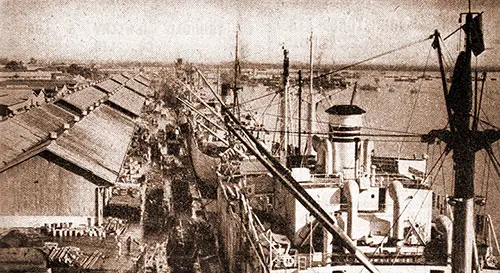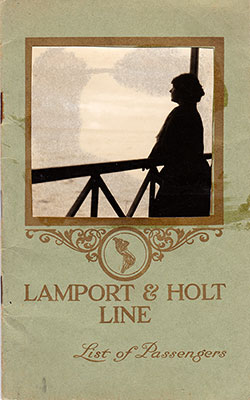Port-of-Spain, Trinidad and Tobago Passenger Lists 1914

Busy Port and Harbor of the Port of Spain in Trinidad and Tobago circa 1952. GGA Image ID # 170fa000e8
Passenger Lists available from the GG Archives from the Port of Port-of-Spain, Trinidad and Tobago. Organized by Date of Departure, Steamship Line, Steamship or Ocean Liner, Class of Passengers, Route, and the Ship's Captain.
Port-of-Spain, the capital, situated on the shores of the Gulf of Paria, about two miles from the mouth of the Caroni River, and described in Whitaker’s Almanack as being one of the finest towns in the West Indies, occupies the site of an old Indian village named Conquerabia.
The city of Port of Spain is the seat of government and capital of Trinidad, and contains a population of about 30,000 inhabitants. It is situated on the shore of the south extreme of a low Hat plain at the base of St. Anne mountains, which rise to the height of 2,140 feet, at 3 miles northeast from the city; at 4 mile to the eastward it is overlooked by the Lavantille hills, or Abercrombie heights, a fork, from the northern mountains; and on the summit of a small hill, 410 feet above the sea, may be seen the ruins of St. David’s tower, but it is not a prominent object.
The city is regularly built, with wide streets, and it has some fine buildings, amongst which are the custom house, market, and numerous churches. About 3 miles to the northwest is Fort George, with a signal post 1,120 feet above the sea, which communicates with the, city and a post on the north side of the island before mentioned. The valley is drained on the east side of the city by St. Anne river, and on the west by the Maraval, but they are mere mountain streams.
The wharves at the town have not sufficient depth alongside for loading vessels, which take in their cargoes from large lighters. Hulks are moored in the oiling for the convenience of heaving down; and steam machinery can be efficiently repaired. (The Navigation of the Gulf of Mexico and Caribbean Sea, 1890)

1914-07-09 SS Vandyck Passenger List
- Steamship Line: Lamport & Holt Line
- Class of Passengers: First Class
- Date of Departure: 9 July 1914
- Route: Buenos Aires to New York via Montevideo, Santos, Rio de Janeiro, Bahia (Salvador), Trinidad (Port of Spain), and Barbados (Bridgetown)
- Commander: Captain A. Codogan.
⚠️ About Accuracy in Historical Records Research Tip
Context. The GG Archives presents passenger lists as faithfully as possible to the original documents. While OCR is generally accurate, portions of these collections—especially image captions and some transcriptions—are typed by hand and may include typographical or spelling variations. The original manifests themselves also contained clerical inconsistencies (names recorded phonetically, mid-voyage corrections, etc.).
What this means for your research:
- Search variant spellings of names (e.g., “Schmidt/Schmitt/Smith,” “Giuseppe/Joseph”).
- Cross-reference with immigration cards, passport applications, naturalization files, city directories, and newspapers.
- Treat manifests as primary sources with historical quirks—use them alongside corroborating records.
- For place names, consider historical borders and language variants (e.g., Danzig/Gdańsk, Trieste/Trst).
How to cite. When quoting a name from a manifest, consider adding [sic] for obvious misspellings and include a note such as “spelling as printed in original passenger list.”
Need help? If you spot a likely transcription error in captions, feel free to contact us with the page URL and a brief note—we love community input. 🙏
Curator’s Note
For over 25 years, I've been dedicated to a unique mission: tracking down, curating, preserving, scanning, and transcribing historical materials. These materials, carefully researched, organized, and enriched with context, live on here at the GG Archives. Each passenger list isn't just posted — it's a testament to our commitment to helping you see the people and stories behind the names.
It hasn't always been easy. In the early years, I wasn't sure the site would survive, and I often paid the hosting bills out of my own pocket. But I never built this site for the money — I built it because I love history and believe it's worth preserving. It's a labor of love that I've dedicated myself to, and I'm committed to keeping it going.
If you've found something here that helped your research, sparked a family story, or just made you smile, I'd love to hear about it. Your experiences and stories are the real reward for me. And if you'd like to help keep this labor of love going, there's a "Contribute to the Website" link tucked away on our About page.
📜 History is worth keeping. Thanks for visiting and keeping it alive with me.
